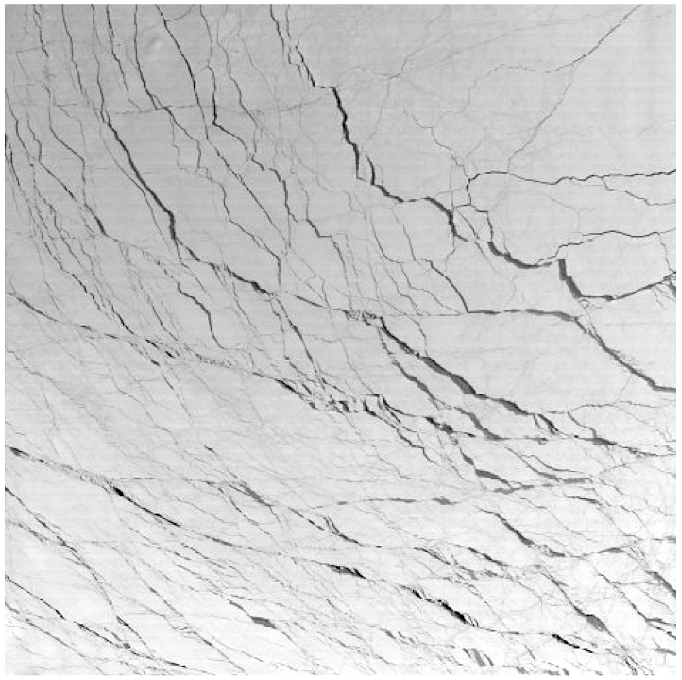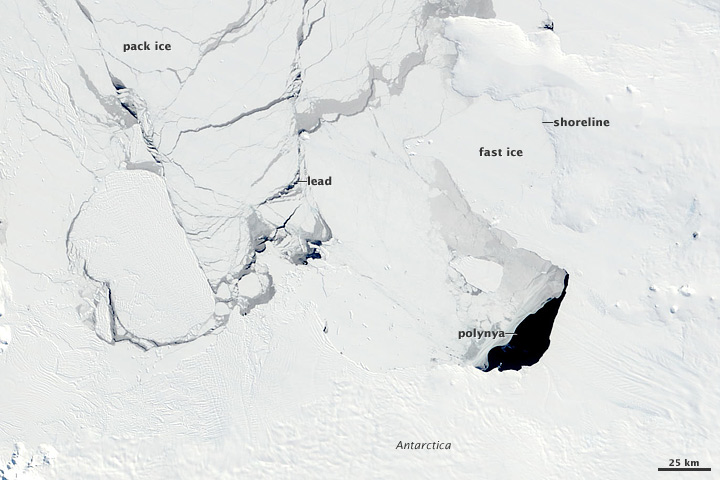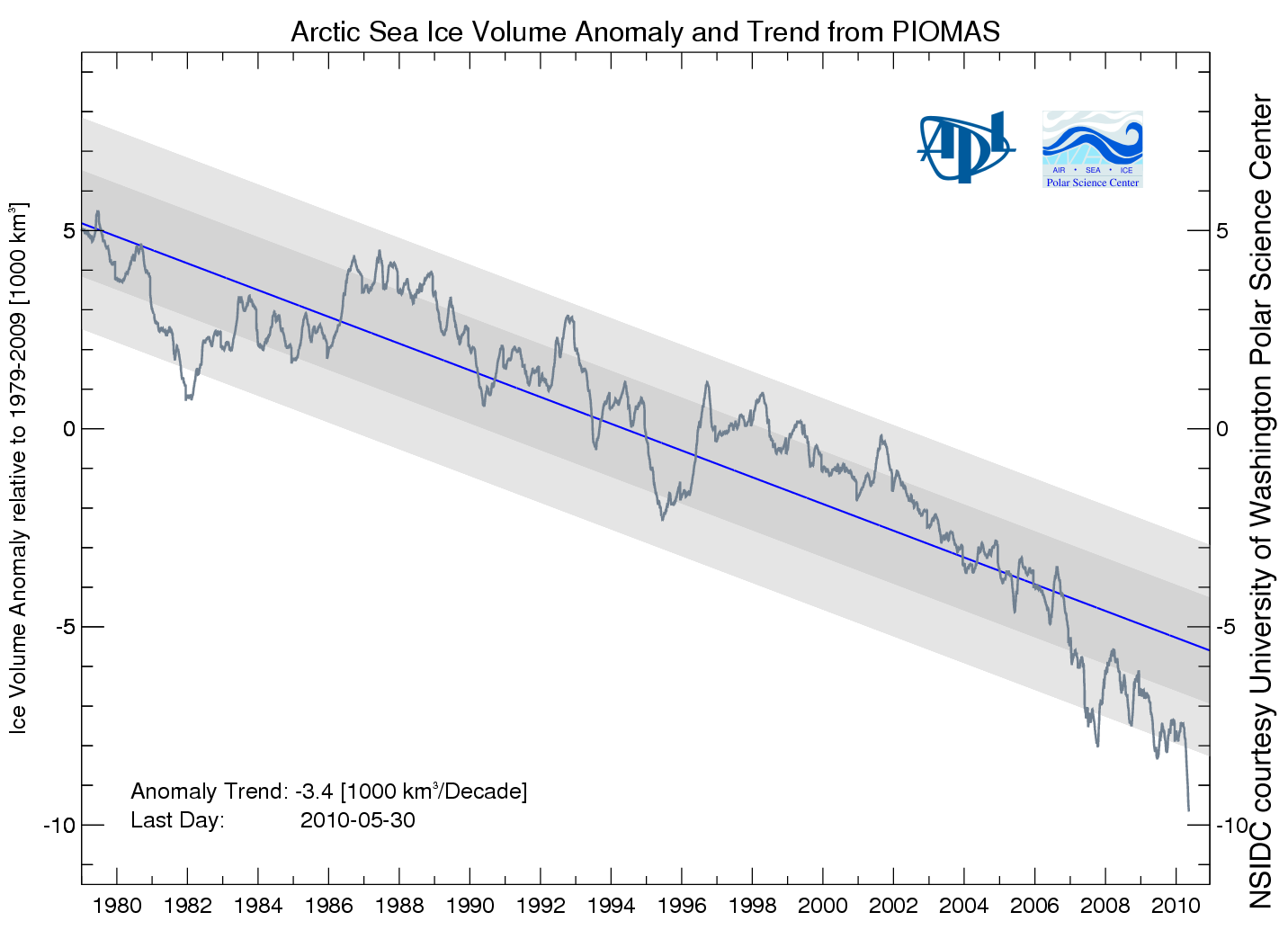About Sea Ice |
 |
Defined as ice that is formed at the sea surface by the freezing of seawater, the formation of sea ice occurs at a lower temperature than pure water (~28.8˚F vs 32˚F, respectively) due to its salinity. In contrast to icebergs, glaciers, ice sheets, and ice shelves, sea ice is formed and melts entirely in the ocean. Sea ice is relatively thin, ranging from a few centimeters to a few meters in thickness.
Sea ice is categorized by age, thickness, and form. In terms of age, sea ice is most commonly divided into "first-year" and "multiyear" ice. Multiyear ice has survived one or more melt seasons. Other age and thickness categories include new ice (less than 5cm), nilas (5~10cm), grey (10~15cm), grey-white (15~30cm), thin first-year (30~70cm), medium first-year (70~120cm), and thick first-year (120~180cm).
Frazil ice is the first stage of sea ice growth, where crystals or plates of ice are suspended in the water. Grease ice is frazil ice that has coagulated to form a "greasy" or soupy layer on the surface without distinct ice floes. Other sea ice forms include pack ice (relatively uniform ice cover over a large area), floes (an individual piece of ice at least 20 m in diameter), pancake ice (pieces less than 3 m in diameter), drift ice (pack ice in concentrations less than six-tenths), and fast ice (attached or frozen or fastened to the shore, also called "landfast ice"). Sea ice is characterized by unique features often found on the ice. Melt ponds are a common response to summer melting of the sea ice surface. Warm temperatures also contribute to the formation of polynyi (singular; polynya), which are nonlinear-shaped openings in sea ice that may be open water or covered with new, thin ice. Leads are a feature that are similar to polynya but are formed by dynamics, not temperature, as sea ice pulls apart and creates long channels. Pressure also contributes to the formation of ridges and hummocks. Ridges form when sea ice is haphazardly piled one piece over another, and hummocks are ridges that have been smoothed by melting and other forms of erosion.
 Sea ice leads in the Beaufort and Chukchi Seas as seen in MODIS satellite imagery. |
 A few sea ice types. (From earthobservatory.nasa.gov) |
A significant fraction of the world’s oceans is covered by sea ice, and it is considered a key component of the climate system because of its influence on surface heat, moisture, radiation, and freshwater fluxes. Sea ice limits exchanges of heat and moisture between the ocean and the atmosphere, acting as a “thermal blanket”. Because of the large difference in reflectivity between ice (bright) and ocean (dark), a reduction in the extent of sea ice will result in more heat being absorbed by the ocean instead of reflected back into the atmosphere. This is likely to amplify the effect of warming in high latitudes, making the extent of sea ice a potential early and sensitive indicator of climate change. Sea ice also redistributes salt and freshwater, as it rejects brine when it freezes. Brine rejection in turn produces saline, cold, and thus dense water in convective regions and polynyas, mainly in the subpolar North Atlantic and the coastal region of Antarctica.
The seasonal sea-ice zone is highly productive biologically, which makes sea ice a key component in the carbon cycle. Fast ice provides important habitat for wildlife, and the shear zone between fast and drifting ice frequently results in open water in these regions, to the benefit of the biota.
As suggested by the Intergovernmental Panel on Climate Change (IPCC) in their 2001 report Climate Change: The Scientific Basis and in the 2005 Arctic Climate Impact Assessment (ACIA), there is a possibility that Arctic sea ice could become seasonal in the coming decades. Such a change would have profound climate implications, and would deeply affect the Arctic ecosystem and Arctic residents. Although variation in trends between the Arctic (declining sea ice extent) and the Antarctic (increasing sea ice extent) do exist, the measurements of sea ice extent and thickness in the Arctic in past years correlates closely with observations of a warming trend in the Arctic. Despite uncertainty of the future, current measurements of trends in both the Arctic and Antarctic suggest a much more significant change in the Arctic towards declining extent (~4.1% per decade) than the less extreme increase of extent in the Antarctic (~0.9%) (NSIDC).

Trend in the anomaly of Arctic sea ice volume over the last few decades from the sea ice model PIOMAS (University of Washington).

Resources:
NOAA Observer's Guide to Sea Ice, 2007.
How Does Arctic Sea Ice Form and Decay?, by Peter Wadhams on NOAA's Arctic theme page.
Sea ice types, by the Australian Antarctic Division.



